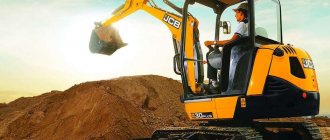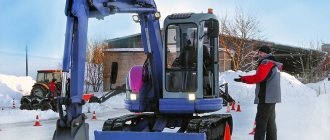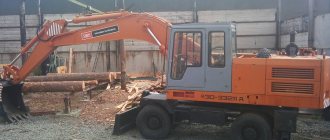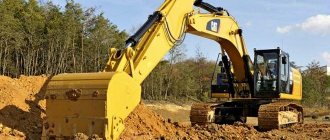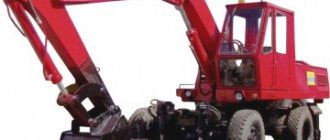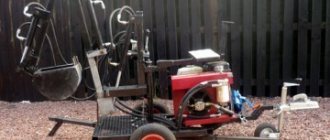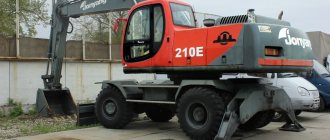How to operate an excavator correctly
Hydraulic excavators are fundamental equipment in the production of many types of earth-moving work or when performing the movement of masses of various types of soil.
According to statistics, the growth in the excavator market annually is 7-8%. At the same time, imports of equipment from abroad show a good increase of 40-45% of this number. It turns out that the entire market for earthmoving equipment is divided between Russian and foreign manufacturers. To the question of which excavator is better when choosing, no expert can answer unequivocally. The arguments are simple: Russian technology is cheaper, and Western technology is more reliable. Therefore, let’s try to understand the question: how to operate an excavator correctly , since with careful work the equipment breaks down less often, but ignorance of the control functions will lead to a definite breakdown. You can download the manual for excavator operators here.
Management of imported equipment
Now let’s answer a detailed question: imported excavator First, let’s decide: what kind of hydraulic excavator do you have? Large or small, you will need knowledge and skills to operate it, but you definitely won’t need physical strength. There will definitely be an instrument panel, like a good passenger car, which will provide the necessary information about all the operating parameters of the car. It contains:
- Tachometer;
- Oil pressure indicator;
- Engine temperature;
- Excavator battery charge;
- Signal indicator - warning about overheating;
- Excavator fluid level;
- Engine hour counting board;
Two joysticks will divide the functions of controlling the excavator, one will be responsible for the movement of the excavator in space and the movement of the near part of the boom, the other will be responsible for the operation of the manipulator boom and the bucket. No matter how complex the work may be, control will require practice, which can be obtained on a computer with a simulator program for this type of excavator.
You need to know that different types of excavators, depending on the manufacturer, have individual control circuits.
Management of domestic equipment
The control features of a Russian-assembled excavator will differ from imported machines by the presence of up to six hydraulic valves directly connected to the hydraulic cylinders of the excavator boom manipulator and the bucket control mechanism.
Two pedals and levers for a tracked vehicle or a steering wheel for a pneumatic chassis will be responsible for the forward movement of the equipment. A course of theoretical training and industrial practice will be the answer to the question of how to properly work on a domestically assembled excavator.
Safety precautions
When working on imported and domestic excavators, you must read the safety instructions developed specifically for a specific model.
Before starting your first work, you must familiarize yourself with the meaning of the special information located on the body and components of the excavator. Warning signs on the machine will be present in all dangerous places, and will have accompanying inscriptions that indicate the level and degree of possible danger:
- A WARNING will signal the possibility of a potential hazard that, if not taken, will result in the potential for minor or moderate injury.
- A WARNING is intended to alert you to a potentially hazardous situation that could result in serious injury or death if necessary precautions are not taken promptly,
- DANGER signals the imminence of a particularly dangerous event, which will result in serious injury or death if safety precautions are not taken.
Signs available at all equators use pictures and inscriptions to provide a visual warning and are mandatory. Safety precautions when working with a crawler excavator are described here.
Do not confuse safety signs with information signs on the operating rules of the excavator. It is necessary to use all knowledge to avoid accidents and to operate the excavator correctly.
Video on the basics of working with an excavator:
OCCUPATIONAL SAFETY REQUIREMENTS DURING WORK
3.1. Installation and movement of the excavator near the excavation (pit, trench, etc.) should be carried out outside the soil collapse prism. 3.2. When moving an excavator within a construction site under its own power, the following safety requirements must be met: 3.2.1. When starting the excavator and during each maneuver, you need to make sure that the movement is safe and that there are no people or obstacles along the route. 3.2.2. Movement of the excavator along a longitudinal slope is permitted subject to the restrictions specified in the excavator's passport. 3.2.3. When moving an excavator, its boom should be in the direction of movement of the excavator, and the bucket should be raised above the ground by 0.5 - 0.7 m. 3.3. When moving the excavator under its own power, you must comply with the requirements of the Road Traffic Regulations. 3.4. When transporting an excavator by trailer, you must know the following safety requirements: 3.4.1. Before loading the excavator onto the trailer, you need to make sure that the trailer is on a level, level surface and is securely braked. 3.4.2. You can roll the excavator onto the trailer using a winch or under your own power along a securely constructed ramp made of beams or sleepers; The ramp flooring should be arranged with a slope of no more than 150. 3.4.3. Before loading, the excavator bucket should be raised so that it does not interfere with movement along the ramp. 3.4.4. The employee is prohibited from making U-turns when entering the trailer and on its platform. 3.4.5. During transportation on a trailer, other workers are prohibited from being in the excavator cabin. 3.5. When excavating soil, the excavator must be installed on a pre-planned site; in this case, the minimum distance from the excavator support to the edge of the pit (ditch) should be from 1 to 6 meters, depending on the depth of the pit (ditch) and the soil (sandy, clay, etc.). 3.6. While the excavator is operating, it is necessary to ensure that there are no people in the danger zone of the working excavator, determined by the length of the boom and the extended handle. 3.7. While the excavator is operating, it is prohibited to: - rotate the platform if the bucket is not removed from the ground; — level the soil, clear the site with a lateral movement of the handle; - clean, lubricate, adjust, repair the excavator with the bucket raised; — carry out any work when people are in the excavator work area; — leave the workplace with the bucket raised. 3.8. To avoid loss of stability or the possibility of tipping over, do not move the excavator with a loaded bucket. 3.9. Soil removed from a pit or trench should be loaded into vehicles or placed outside the collapse prism. 3.10. While the excavator is operating, it is prohibited to be in the range of its boom. 3.11. It is not allowed to develop soil using the “undermining” method; soil development must be carried out in such a way that during the work no “peaks” of soil are formed. 3.12. It is prohibited to lift and move logs, boards, beams, large blocks that do not fit into the excavator bucket. 3.13. Loading soil into a dump truck should be done from the rear or side side. 3.14. It is not allowed to move the excavator bucket over the driver’s cab of the vehicle. 3.15. Loading soil into a dump truck is allowed only if there is no driver or other people in the cab. 3.16. If you need to clean the bucket, lower it to the ground and turn off the engine. 3.17. During a break in work or when performing maintenance on the excavator, the bucket must be removed from the trench, the excavator must be moved away from the edge of the slope and the bucket must be lowered to the ground. 3.18. Carrying out work near underground utilities, as well as in the security zone of an overhead power line, is permitted if there is an issued work permit defining safe working conditions, and under the supervision of the work manager. 3.19. When working on an excavator, it is prohibited to: - transfer control of the excavator to people who do not have the right to do so; — leave the excavator with the engine running; — transport people in the excavator cabin; — be under the excavator with the engine running or with the bucket raised. 3.20. When working on a surface that has a slope, you should not: - make sharp turns of the excavator; — rotate the excavator with a recessed bucket; — move the excavator across a slope whose angle exceeds that specified in the excavator’s passport. 3.21. When work is temporarily stopped, the excavator must be installed in such a way that the boom is retracted in the opposite direction from the trench, the bucket is lowered to the ground, and thrust blocks are placed under the chassis on both sides. 3.22. If you need to leave the excavator cab, you need to put the gear shift lever in neutral and brake the excavator. 3.23. While refueling the excavator, the employee and other people near the excavator are prohibited from smoking or using fire. 3.24. When maintaining and repairing an excavator, you need to inspect the tool that will be used in the work and make sure it is in good condition. 3.25. The dimensions of the jaw (grip) of the wrenches should not exceed the dimensions of the bolt heads (nut faces) by more than 0.3 mm; in this case, the use of shims is not allowed if the gap between the planes of the jaws and the heads of bolts or nuts is more than permissible; the working surfaces of the wrenches should not have knocked down bevels, and the handles should not have burrs; when loosening and tightening nuts and bolts, it is prohibited to extend the wrenches with additional levers, second wrenches or pipes; If necessary, you need to use keys with long handles. 3.26. Sliding keys must not be loosened in moving parts. 3.27. The screwdriver should be selected according to the width of the working part (blade), depending on the size of the slot in the head of the screw or screw. 3.28. The hammer heads must have a smooth, slightly convex surface without warps, chips, gouges, cracks or burrs. 3.29. The handles of hammers and other impact tools must be made of dry hardwood (birch, oak, beech, maple, ash, rowan) without knots or cross-layers or from synthetic materials that ensure operational strength and reliability in operation. 3.30. A portable lamp used for maintenance or repair of an excavator must be powered by low voltage (up to 42 V).
All the necessary information on driving an excavator for beginners
Specialized training centers provide training for the excavator profession. To obtain a license for an excavator, you must not only master the principles of operating a technical device, but also have knowledge of the maintenance and repair of the base machine and its attachments, have the skills of a mechanic, be able to read drawings and diagrams of parts, and even understand the categories of soil.
The prestige of a profession is determined by its demand in the labor market. Excavators are in high demand. This special equipment is indispensable in the development of mine workings, quarries, and in the field of civil and road construction. Machines equipped with a bucket are used for digging trenches and pits or creating embankments and dumps, excavating soil or constructing dams. The machines are used not only for the extraction of iron ore, coal and other rocks, but also as loaders of bulk materials into vehicles.
A professional excavator operator is always provided with work and a stable income. And everyone with an excavator license can improve their rank over time by taking advanced training courses. The maximum professional level is 8th category.
What licenses are needed for an excavator?
For special equipment on tracks or wheels, special categories of rights have been developed:
- B - gives permission to operate small tracked vehicles with a power of up to 25.7 kW;
- C - for specialized wheeled vehicles with power up to 110.3 kW;
- D - suitable for controlling powerful wheeled special equipment (over 110.3 kW);
- E - for controlling powerful tracked vehicles (more than 25.7 kW);
- F - designed to control special-purpose agricultural machinery.
To obtain an excavator operator’s license for a particular model, you need to compare the category and power of the machine you will be working on.
Many enterprises in the construction, public utilities or agricultural sectors willingly employ drivers who have only one special category. But those companies that strive to achieve greater operational efficiency are willing to accommodate those who want to study to become excavator operators. A competent employer understands that the interchangeability of specialists is the key to stable work.
Those who want to study and receive an additional category should take into account that when transferring from one type of machine to another, the training will take place within the framework of an additional shortened program. Certification will be required.
If the enterprise plans to transfer the driver from one model of excavator to another of the same type, then no additional training is required. In such a situation, the excavator operator must familiarize himself with the features of the proposed special equipment, undergo an internship for 5-8 shifts, and only after that begin independent work.
After starting the machine
Having started the engine, the driver lets it run for up to five minutes at low speeds, and then supplies fuel at idle speed to check the functionality of all equipment components without load.
By activating the levers one by one, the operator checks all control mechanisms, brakes, steering wheel, lighting and signals, and the operation of the hydraulic part. The final stage of testing after starting the chassis is a control verification of instrument readings.
Where to train to become an excavator operator
Study programs to become an excavator operator were developed by the State Committee of the Russian Federation for Vocational Education. Now they are approved by regulations of the Ministry of Education.
Now you can learn to be an excavator operator or a forklift driver not only in vocational schools, but also in training centers and manufacturing plants.
All educational institutions that teach how to operate an excavator must have an appropriate production base for conducting practical training. The practical part of the exam must take place at a tractor track and on a specially prepared route.
Education
Persons who have reached the age of 18 and have no medical contraindications for study and further work are allowed to study the profession of an excavator. A medical certificate according to the established sample is issued on a paid basis. You must also present a certificate of payment of tax (state duty established by state technical supervision authorities).
Vocational training is carried out full-time and should include:
- theoretical classes in specially equipped classrooms;
- practical lessons;
- examination events with the participation of Gostekhnadzor inspectors.
Training programs for drivers of wheeled and tracked vehicles are drawn up taking into account the fact that, in addition to the skills of operating special equipment, the graduate will also acquire knowledge of vehicle maintenance and repair.
An excavator operator must be able to detect and troubleshoot problems, understand the operating principle of equipment, understand drawings, fuels and lubricants and their consumption rates, and know the basics of electrical engineering.
All this knowledge at the end of the course is checked by a certification commission, which must include a representative of Gostekhnadzor. The result of the certification is entered into the protocol. The excavator operator receives a certificate indicating the type of machine he is authorized to operate. The certificate is signed by the chairman of the examination committee.
In training centers, the course of study is designed for 300 or more academic hours and lasts from 2 to 4 months. The price is set by the centers themselves; in most educational institutions, obtaining the profession of an excavator operator costs about 7 thousand rubles, each subsequent increase in grade costs about 2.5 thousand rubles.
Increase in rank
After receiving a certificate, an excavator operator who has completed training for the first time has the right to operate a single-bucket machine with a volume of no more than 0.15 m³, since he is assigned a 4th category. To increase the rank, you will need to undergo training according to a shortened curriculum and pass an exam. Training for each higher level can be completed after a year of work with the previous qualification.
Increasing the rank indicates the professionalism of the driver. All categories and salaries of specialists are included in the unified tariff and qualification directory of jobs and professions. With each rank, wages increase, and the excavator operator receives permission to operate a more powerful machine in terms of bucket volume and productivity:
- 5th category - allows you to work with a bucket volume of up to 0.4 m³ and on trench rotary excavators with a productivity of up to 1000 m³/h;
- 6th category - bucket up to 1.25 m³, productivity - up to 2500 m³/h;
- 7th category - volume up to 4 m³, productivity up to 4500 m³/h;
- 8th category - volume up to 9 m³, productivity more than 4500 m³/h.
Useful tips
Before starting work, you need to study all the icons on the body and units of each excavator. Graphics and labels contain cautions, warnings, and danger signals. The signs are intended as a visual reminder, but should not be confused with safety instructions, which must be followed.
Initial briefing (introductory) is carried out upon hiring, repeated - at least once a quarter. In some situations, an extraordinary briefing is carried out (the driver switches to another model of special equipment, he has been issued a permit for hazardous work, he has violated safety rules or caused an accident, etc.). TB specialists record information about the training.
To ensure safe work, young excavator operators must always follow the rules and listen to the advice of experienced colleagues. Among the mandatory ones are simple but extremely important recommendations:
- Before starting work, the excavator operator must sound a sound signal. This way, nearby colleagues will be warned that the car is starting to move.
- The working area of the excavator should be fenced off whenever possible. The operator must keep an eye on the job site and clear space while rotating the bucket.
- If you have to work on a slope or loose soil, you must first prepare a hard horizontal surface to prevent the equipment from tipping over.
- Before starting work, you need to study the area. Working near power lines or where underground utilities are located is dangerous.
With time and increasing professional experience, compliance with safety rules at work can be brought to automaticity. But experienced excavator operators are advised to repeat the safety rules from time to time and become familiar with those developed for modernized models of special equipment.
OCCUPATIONAL SAFETY REQUIREMENTS IN EMERGENCIES
4.1. If there is a danger of collapse or sliding of the soil, you should immediately move the excavator to a safe place. 4.2. If a pipeline, electrical cable, explosive or other unknown objects are found in the excavated soil, the work of the excavator should be stopped immediately and the work manager should be informed about this. 4.3. If an accident occurs while the excavator is working, the work manager must be notified immediately. 4.4. If a fire or signs of combustion are detected in the work area (smoke, burning smell, increased temperature, etc.), you must immediately notify the fire department by calling 101 or 112 and take measures to extinguish the fire using primary fire extinguishing agents. 4.5. In the event of an accident or sudden illness, it is necessary to immediately provide first aid to the victim, call a doctor by calling 103 or 112 or help take the victim to a doctor, and then inform the manager about the incident. 4.6. If an accident occurs with the employee himself, then he should go to the health center, and also report the incident to the manager or ask someone around him to do this.
Excavator operator: learning process and basics of the profession
An excavator is a complex engineering machine designed for various types of excavation work and loading bulk materials. Only certified specialists who have been trained as excavator operators in specialized training centers can perform operational functions on this high-tech mechanism. The driver’s activities include not only the management of this unit, but also its maintenance.
The profession of an excavator operator requires deep skills and a large amount of engineering knowledge, which are associated with the ability to analyze technical documentation and drawings. In order to correctly select working equipment and a place for carrying out the technological process, each excavator operator must have professional knowledge about all types of soils and their physical and mechanical characteristics.
The work process places high demands on the driver to comply with all norms and regulations relating to the safety of earthmoving and loading and unloading operations, as well as a responsible and serious attitude towards the functions performed. In addition, the excavator driver, while carrying out his activities, is exposed to significant stress, and therefore must have excellent health and good physical fitness.
The process of training to become an excavator operator
Training to become an excavator operator is carried out in specialized educational institutions, where applicants master a vocational training program. The purpose of the training courses is to gain skills in driving a wheeled or tracked unit, as well as to learn the skill of developing and moving soil using a bucket. The study consists of three stages:
- The theoretical part. Each student studies the design of an excavator and its main elements, as well as methods of conducting soil development work using a bucket and other attachments.
- Practical component. During the classes, each student can learn to operate an excavator and manipulate its bucket.
- Internal exam. After graduating, all applicants take exams: theoretical and practical. The theory exam is taken on tickets, where the main issues of the design of an excavator and methods of excavation work are discussed. Practical knowledge testing is carried out at the training ground. Here, the future excavator driver demonstrates his driving skills and demonstrates how to manipulate the bucket.
Upon completion of training and successful passing of the exam, the applicant receives documents of the established form - a certificate of completion of courses and a driver’s license with a qualification category.
A certified excavator driver must be competent not only in professional matters, but also have the necessary technical skills.
Knowledge that an excavator operator must have
A modern tractor and excavator driver must be fluent in all types of loading and unloading equipment. And if he has gaps in knowledge and skills related to any unit, he needs to learn at a training center and raise his level to a new level.
A number of fundamental issues that an excavator operator should know:
- design and technical data of the excavator;
- features of the operation of technological equipment: mechanical, electrical and hydraulic;
- basic provisions for conducting mining operations;
- purpose and principle of operation of measuring instruments and devices;
- technology of work related to laying main pipes;
- methods for developing various categories of soils;
- types of parts and components that wear out and become unusable most quickly, the sequence and methods of replacing them;
- causes of problems and methods for preventing them;
- rules for transporting an excavator.
Control readings
It is necessary to check the performance of working units using instruments. They must comply with the ranges below:
- oil pressure, MPa – 0.2-0.3;
- radiator water temperature,
OC – up to 95;
- fuel system pressure, MPa – up to 0.1, in the compressor – up to 0.2;
- air pressure in pneumatic units, MPa – up to 0.8;
- steering pressure when changing the wheel position, MPa – up to 4.
If any indicators do not meet the standards, the control check of the nodes in which deviations are found should be repeated. Otherwise, safe use of the equipment is not guaranteed.
Requirements for candidates
Today, the profession of excavator driver is one of the most sought-after specialties in the field of construction and mining. Nowadays, no construction industry can do without the services of a highly qualified excavator operator.
In order to undergo training in operating an excavator, the following conditions must be met:
- The candidate must be at least eighteen years old;
- medical certificate permitting to carry out professional activities in this specialty;
- availability of a tractor driver’s license of categories “B”, “C”, “D” and “E”.
When all formalities are completed, the candidate submits the necessary documents to the commission, signs an agreement with the training center and pays for the courses.
Driver's responsibilities
A trained and certified excavator driver must perform the following functions:
- carry out the development and movement of soil during various types of construction and open-pit mining;
- Perform timely maintenance of the excavator: refill with fuel and lubricating oils;
- regularly monitor the operation of the chassis system elements;
- periodically inspect the working components of the machine: ropes, engine, brake systems and their fastenings;
- systematically monitor the readings of measuring instruments;
- carry out preventive measures and carry out repair work;
- maintain approved technical documentation.
Use in winter
With the onset of cold weather, additional maintenance of excavators is required, which involves replacing the oils - hydraulic system, power unit, transmission - with more viscous ones.
In addition, proper operation of the excavator requires the mandatory use of a pre-heating system for the air supplied to the engine and does not allow high speeds to be supplied during startup.
The best way to solve a problem is to prevent it. Therefore, it is very important to carry out maintenance on time and correctly using original consumables and involving qualified repair specialists in the process.
Excavator Tutorial
Today, one of the most authoritative and popular manuals on specialized mechanisms is the book “Single-Bucket Excavator Operator” by U. I. Saponenko. This textbook discusses important issues in the training of specialists in the profession of machinist. The most important of them:
- excavator device;
- the principle of operation of components and mechanisms: diesel engine, transmission system, chassis, control complex, hydraulic system and attachments;
- types of work performed using various work equipment;
- norms and rules for the safe operation of the unit;
- labor protection requirements when working on an excavator;
- environmental protection conditions.
This training manual is primarily intended for training and advanced training of workers specializing in excavator operator. The book reveals the most competent and professional approach to training modern specialists.
OCCUPATIONAL SAFETY REQUIREMENTS AFTER WORK COMPLETION
5.1. At the end of the work, you need to place the excavator in the designated parking area and lower the bucket to the ground. 5.2. It is prohibited to leave the bucket in a raised position after finishing work. 5.3. At the end of the work, you should put the excavator in order, remove tools, materials, etc. 5.4. Rags, rags and other materials used during cleaning should be placed in a specially designated place (for example, a metal box with a locking lid). 5.5. Take off protective clothing, put away personal protective equipment, protective clothing in the designated place. 5.6. Wash your face and hands with warm water and soap or take a shower. Upon completion of work, you should inform the work manager about any problems noticed during work that could lead to an accident.
Excavator driver simulator
Today, in many training centers, excavator operator training is carried out using a special operator simulator. It is a high-tech complex that simulates the activity of a single-bucket excavator. You can practice your professional skills on it no worse than on a real unit. It is equipped with a panoramic display, a driver’s seat, levers and pedals that replicate a real piece of equipment.
Advantages of the simulator when conducting training sessions:
- safety of work and absence of risk of harm to the health of the student or the excavator;
- the most realistic simulation of work situations;
- all objects of virtual space have physical characteristics;
- the pedals and levers are controlled in the same way as on a modern mechanism;
- all factors of the driver’s work are taken into account;
- speed and efficiency of consolidation of professional skills;
- due to its ergonomics, the exercise machine can be installed in any room;
- You can make individual settings for each operator.
The use of this simulator for training students as excavator operators is cost-effective and safe. The conduct of classes does not depend on weather factors and the presence of an excavator at the training site.
It is always important to remember that a highly qualified professional becomes a specialist who can not only perfectly control a complex mechanism, but also correctly operate it, as well as perform high-quality repairs of the unit.
How to operate an excavator
Construction is a rather complex process that involves quite a few different types of work. Among them, soil cultivation, which is carried out in most cases by excavators, occupies a special place.
These mechanisms are quite expensive, so not every consumer can afford to buy it. An alternative is to simply rent an excavator for a certain period of time, which makes it possible to complete all assigned tasks.
Final preparation
After all of the above operations have been completed, you should fill the engine tank and, if necessary, add water to the cooling system. Then the operator needs to inspect the excavator for the presence of foreign objects and turn on the neutral speed position.
Afterwards, the main clutch is turned off, and the driver makes sure that all friction clutches, the platform drive and the reverse mechanisms are turned off. The engine must be started in accordance with the recommendations specified in the documentation for the chassis engine.
Preparatory work
An excavator is a very complex mechanism, so operating it will not be easy and requires certain skills. Before you begin this process, you should follow a few simple recommendations:
- First of all, you need to become familiar with the system of the machine itself. Working bodies and structures for controlling them should be identified.
- Before starting work, be sure to check that the excavator is working properly. To do this, it should be inspected for damage and other similar defects.
- After this, be sure to study the operating instructions. This will help you understand all the buttons, levers and other elements.
Before using the excavator
Preparing an excavator for work begins with activities before turning on the engine; the driver must check:
What is an excavator
- presence of oil in all systems;
- presence of fluids in the hydraulic system;
- fuel tank full;
- all drain valves are closed;
- battery charge;
- wheel condition, tire pressure;
- correct laying of ropes on drums;
- integrity of the bucket, condition of the teeth;
- the condition of the chassis and the attachment of the working element to it;
- availability of spare parts.
At the end, all working components of the machine are checked for water and oil leaks.
This is interesting: What are the rules for working at heights?
Let's get started
The excavator control process should begin by following simple recommendations:
- First, you should get behind the wheel and start the engine so that it warms up for a certain time. Also make sure that all working parts are located on the ground.
- After this, you should release the parking brake and try to move the excavator forward. In this case, it is advisable to immediately use only low speeds in order to get used to the operation of the device.
- The next step is to study the functioning of the main organs. They can be controlled using either levers or joysticks. You should lift the bucket slowly, understanding in which direction it should move.
To try digging, you should put the excavator in the rear position and place it on special supports. After this, you can try to control the boom and work with the soil.
Please note that excavators can differ radically from each other, both in power and control system. If you want to learn how to work efficiently with such machines, then it is advisable to take special courses where you can gain experience. Only constant work with the excavator will allow you to feel it correctly and perform the most complex tasks.
